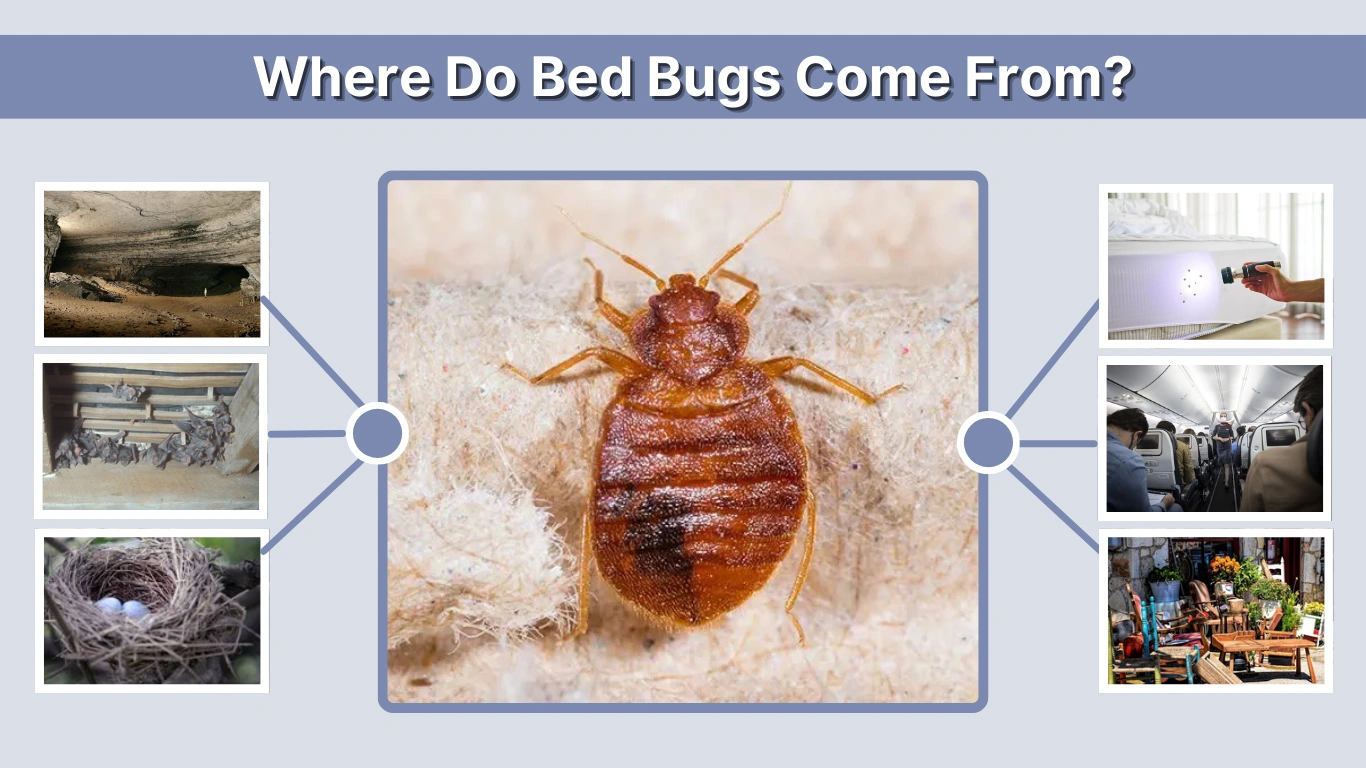Bed bugs are one of the most persistent household pests worldwide. Known for their tiny size and itchy bites, these insects have puzzled homeowners for generations. Many people wonder where bed bugs come from and how they end up in houses, hotels, and apartments. Understanding their origins, natural habitats, and ways of entering human spaces is essential for prevention and control.
Understanding Bed Bugs
Bed bugs are small, reddish-brown, wingless insects that survive by feeding on blood. Adults are about the size of an apple seed, making them difficult to spot until an infestation grows. Unlike some pests, they do not spread diseases, but their bites often cause irritation, allergies, and anxiety for people who experience infestations.
A common misconception is that bed bugs are attracted to dirt or poor hygiene. In reality, they are opportunistic feeders drawn to warmth, carbon dioxide, and human blood. This means that even the cleanest home or hotel can suffer an infestation if the bugs manage to find their way inside.
Origins of Bed Bugs
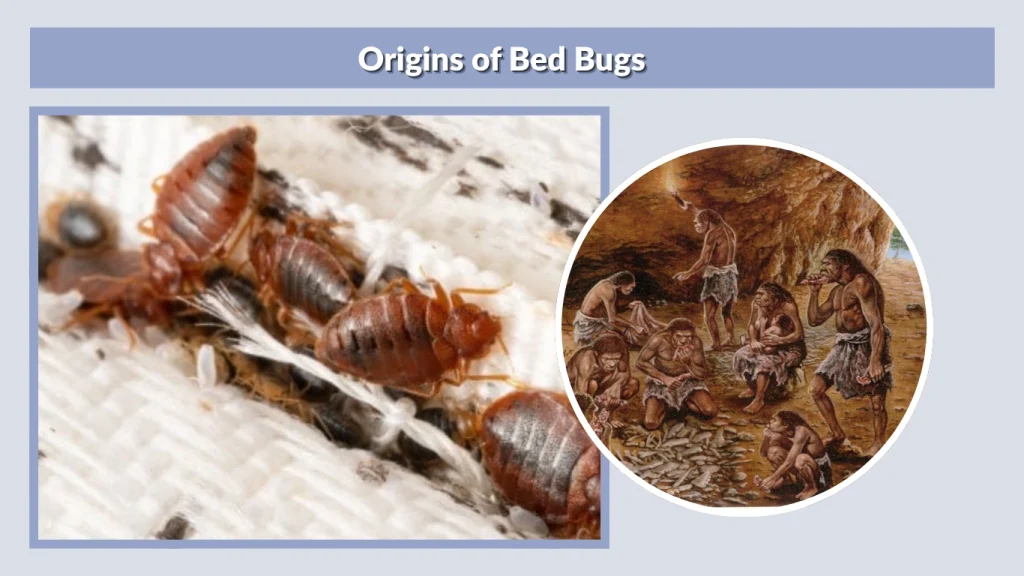
Historical Background
Bed bugs are not new invaders. Fossil evidence suggests that they have been around for thousands of years, feeding first on animals before adapting to humans. Ancient civilizations, including the Egyptians and Greeks, documented the presence of bed bugs in writings and remedies.
Their close association with humans likely began when early people lived in caves. Bed bugs fed on both bats and humans in these dark, enclosed spaces, gradually shifting to human hosts as settlements grew. With the rise of trade and travel, bed bugs spread across continents, hitching rides on ships, caravans, and goods.
Global Spread
Bed bugs nearly disappeared in developed countries during the mid-20th century, largely due to widespread pesticide use. However, in recent decades, they have made a strong comeback. Increased international travel, resistance to insecticides, and the popularity of second-hand furniture have all contributed to their resurgence. Today, they are found everywhere—from high-end hotels to modest homes—proving they are not bound by geography or social class.
Where Bed Bugs Come From in Nature
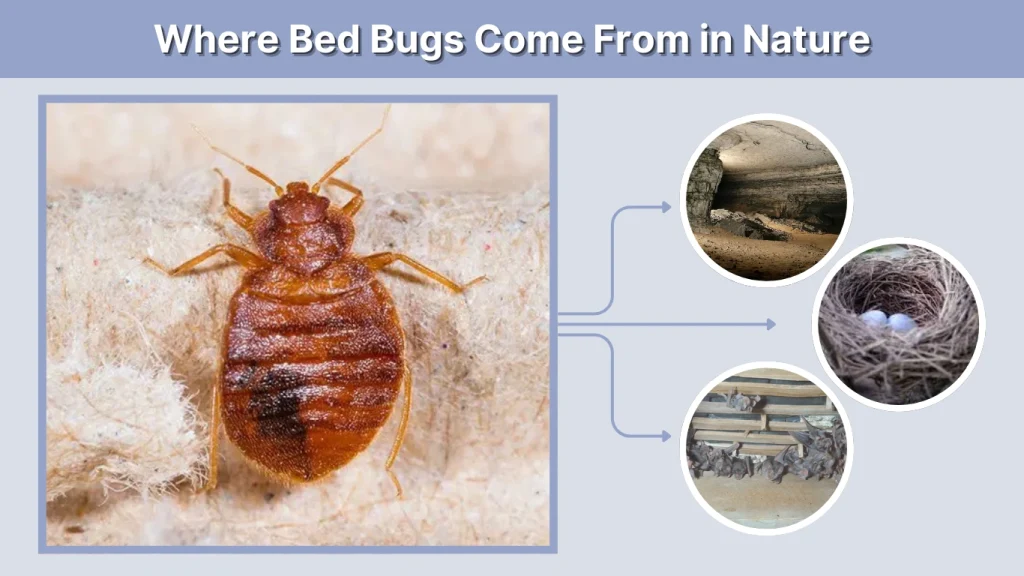
Before adapting fully to human environments, bed bugs thrived in natural shelters. Their original habitats included caves, bird nests, and bat roosts. These locations provided warmth, darkness, and access to blood meals. Over time, bed bugs evolved to take advantage of humans as reliable hosts.
Even today, some species of bed bugs live in the wild, primarily feeding on bats or birds rather than people. However, the common bed bug (Cimex lectularius) is now almost exclusively dependent on human blood. Its ability to survive months without feeding makes it highly resilient, allowing infestations to spread even when food sources are temporarily unavailable.
How Bed Bugs Enter Homes
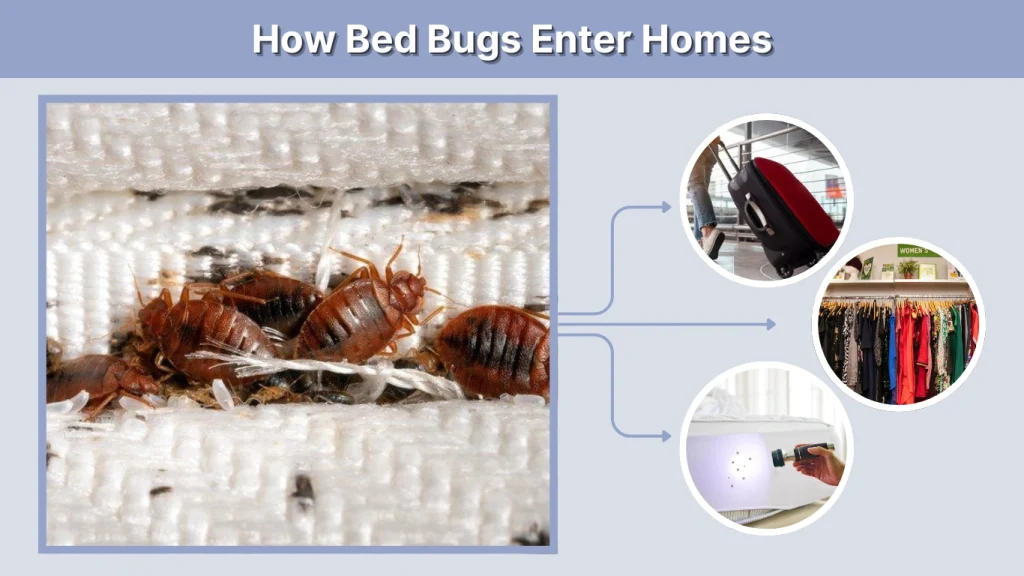
Hitchhiking Pests
One of the main ways bed bugs spread is by hitchhiking. They do not fly or jump, but they cling to luggage, clothing, and personal belongings. A single overnight stay in an infested hotel room can be enough to bring them home.
Second-hand furniture, especially beds, sofas, and chairs, is another major source of infestations. Bed bugs can hide deep in seams and crevices, remaining unnoticed until they spread throughout a house. Moving trucks and rental furniture can also unknowingly carry them from one location to another.
Apartment Complexes and Shared Spaces
For those living in apartments, bed bugs can spread between units through walls, electrical outlets, or pipes. Shared laundry facilities may also pose a risk if infested items are not properly contained. Dormitories, shelters, and other communal living environments face similar challenges, as close quarters make it easier for bed bugs to move from one person’s belongings to another’s.
Where Bed Bugs Hide in the House
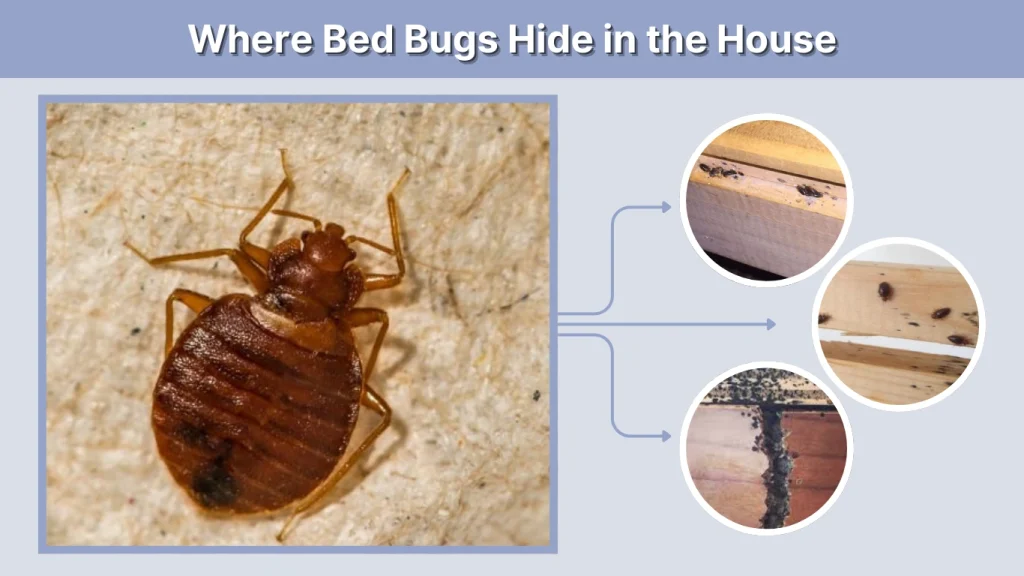
Once inside, bed bugs are experts at hiding. Their flat bodies allow them to squeeze into tiny cracks and crevices. While mattresses and bed frames are their most common hiding places, they can also settle in less obvious spots.
Common Hiding Spots
- Mattress seams, box springs, and bed frames.
- Cracks in walls, headboards, and baseboards.
- Behind wallpaper or inside picture frames.
- Upholstered furniture and cushions.
- Even electronics such as alarm clocks, laptops, or televisions.
Because of their secretive nature, infestations often remain unnoticed until they become severe. Bites, blood stains on sheets, and small black droppings are usually the first signs people notice.
Common Triggers and Causes of Infestation
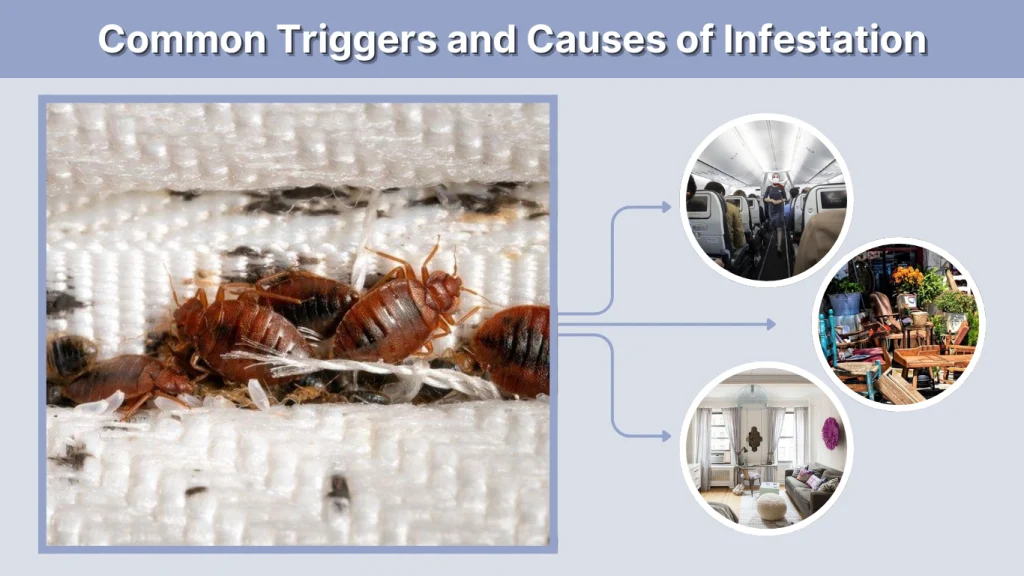
Bed bugs spread quickly because they are highly adaptable. Unlike other pests that require specific environmental conditions, they can thrive almost anywhere humans live. Some of the most common triggers and causes include:
- International travel: Airports, hotels, and public transport are hotspots for bed bug transfer.
- Second-hand furniture: Mattresses, couches, and wooden furniture often carry hidden bed bugs.
- Dense living arrangements: Apartments, dormitories, and shelters make it easy for them to spread between rooms.
- Increased resistance to insecticides: Modern bed bugs have adapted to survive treatments that were once effective.
Where Bed Bugs Come From at Night and Day
Night Activity
Bed bugs are nocturnal feeders, meaning they are most active at night. They are attracted to human warmth and the carbon dioxide we exhale while sleeping. Typically, they emerge from their hiding spots just before dawn, feed for 5–10 minutes, and then return to their shelter.
Daytime Hiding
During the day, bed bugs avoid light and remain hidden in tight spaces. They stay close to their food source, which explains why they are often found near beds, couches, or chairs where people sit or sleep for long periods.
Myths About Bed Bug Origins
Bed bugs have been surrounded by myths for centuries. Understanding what does not cause infestations is just as important as knowing their real sources.
- Not caused by poor hygiene: Bed bugs don’t discriminate between dirty and clean homes.
- Not linked to poverty: Wealthy hotels and resorts also deal with infestations.
- Not “born” in mattresses: Mattresses are hiding places, not their place of origin.
- Not outdoor garden pests: They don’t come from soil or grass like other insects.
Prevention and Control
While completely eliminating the risk of bed bugs is difficult, careful habits can greatly reduce the chances of an infestation.
Prevention Tips
- Inspect luggage and clothing after traveling.
- Vacuum and steam clean regularly, especially around sleeping areas.
- Carefully check second-hand furniture before bringing it inside.
- Use protective mattress encasements to block hiding spots.
- Seal cracks in walls, floors, and furniture where bugs might hide.
Control Methods
If an infestation does occur, professional extermination is often necessary. Heat treatments, chemical sprays, and thorough cleaning are among the most effective strategies. Early detection is critical, as small infestations are easier to control than widespread ones.
Conclusion
Bed bugs are ancient pests that originated in natural habitats like caves and bird nests before evolving to live with humans. Today, they spread mainly through travel, furniture, and communal living environments. Infestations do not reflect cleanliness but rather exposure to contaminated spaces or items. By learning where bed bugs come from and how they behave, homeowners can take proactive steps to protect themselves and respond quickly to potential outbreaks.
FAQs
What are bed bugs and where do they come from?
Bed bugs are small insects that feed on blood, mostly from humans. They originally lived in natural shelters like caves and bird nests but adapted to humans over time. Today, they spread through travel, furniture, and shared living spaces.
Where do bed bugs come from in the house?
Inside homes, bed bugs usually hide near sleeping areas such as mattresses, bed frames, and box springs. They can also hide in cracks, baseboards, upholstery, or even electronics, making them difficult to detect.
Do bed bugs come from outside?
Unlike ants or flies, bed bugs don’t typically come from outdoor environments like gardens. They are mainly transferred indoors via luggage, clothing, or used furniture rather than naturally invading from outside.
What causes bed bug infestations?
Infestations are caused by exposure to infested areas, especially hotels, apartments, or second-hand furniture. They spread easily due to their ability to hitchhike on belongings and survive for months without feeding.
Where do bed bugs hide during the day?
During the day, bed bugs remain in dark, tight spaces such as mattress seams, bed frames, headboards, or cracks in walls. They avoid light and only emerge at night to feed.

